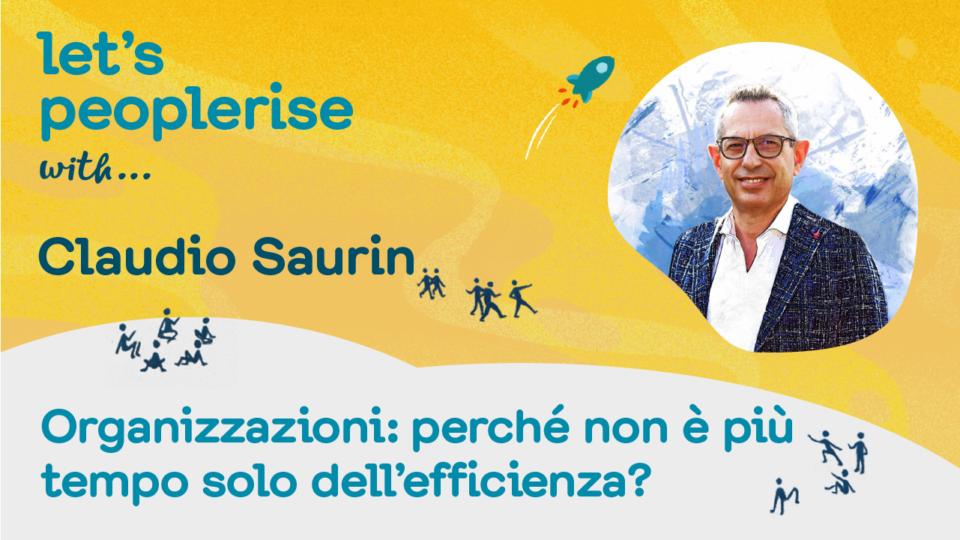From troubadours to researchers
When I do something for the first time, how can I be efficient? Efficiency is achieved by repetition. which leads to continuous improvement, just like athletes and musicians do…
We talk about innovation and no one says that innovation is not necessarily related to efficiency. Because in innovation you go by trial and error. _C. Saurin
C. Saurin, host of the second episode of Let’s peoplerise with… in dialogue with Antonio di Stefano and Ilaria Buccioni, distinguishes efficiency from effectiveness in this way. According to his view, there are in fact some specific conditions allowing to act in pursuit of efficiency and some situations in which it is necessary to act with a view towards effectiveness.
In fact, efficiency can be pursued if the organisation has the tools to repeat the same process many times. Only through standardisation and repetition of actions it is possible to develop efficient processes for the company.
Often, however, efficiency, in the common narrative, turns out to be the only element taken into consideration when evaluating a good organizational process. Does it make sense for it to be so? What are the cases in which efficiency alone should not be looked at? In all those processes that aim for innovation, whether technological or social, efficiency is not pursuable because it is necessary to act with a process of trial and error through creativity.
In this sense people, when pursuing innovation processes, need to develop skills as real seekers of the new, putting on the back burner the valuable skills as trobadeurs of something already given, while looking at the effectiveness of the innovations created.
From dualism towards synergy between efficiency and effectiveness
In this sense, the agile approach brings excellent methodological benchmarks for the trial-and-error approach in organisational contexts. This methodology allows the sense of uncertainty to be experienced with a certain awareness.
This cult of uncertainty and of the imperfect could help a lot to become ambivalent, to become right and left. _A. Di Stefano
An extremely interesting element is the concept of complementarity between agile and lean methodologies. These two methodologies are often observed as mutually exclusive. C. Saurin, on the other hand, points out an interesting relationship between them. Here it is useful to be helped by a clear and explanatory metaphor: what is the difference between Formula 1 and the Paris-Dakar?
Every formula 1 race is planned down to the last detail, the drivers study the route in minute detail, the mechanics know every component of the car to perfection so that the whole race is extremely efficient.
In the Paris-Dakar, the drivers know the starting and finishing points of the route and have to develop a creative strategy to cover it in the shortest possible time. This first difference underlines the different mindsets required in the two types of races.
Another fundamental element to be taken into account is the means by which the competition is run. In this sense, it is important to understand what the limits and strengths of the two approaches are, and to integrate them with meticulous attention while taking into account the different underlying logic.
This difference is clearly emphasised by D. Pink – the author of “Drive” – who differentiates between two types of jobs: creative jobs and algorithmic jobs. Algorithmic jobs are finally in danger of being conducted mostly by machines or replaced by artificial intelligence, which are tools that guarantee maximum efficiency. It is precisely for this reason that the importance of developing the ability to search in uncertainty is highlighted.
How can an agile transformation be activated?
In order to act in an agile manner, it is necessary, in addition to practice, to work at the cultural level to foster an integrated transformation. This is why we define two conditions that help the transformation process:
- From cost to pre-production investment: it is necessary to nurture a different point of view from the one that considers research only as an organisational cost. In this sense, by viewing research and innovation processes as pre-production investment processes, they will be untied from the cost or billing dualism.
- Middle management as facilitator of implementation: agile transformation cannot be activated exclusively with a bottom-up logic. In the transformation process it is important to involve all the people who feed the organisational logic. However, in its pioneering phase, sponsorship by at least a few people belonging to the top management is necessary, with a strong participation of middle management that facilitates the dissemination of the principles.
Go to the live page and watch the video
Daniel Pink, Drive

